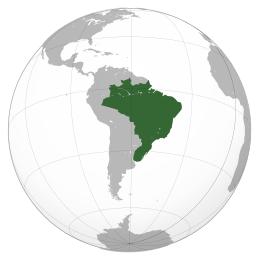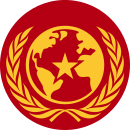More languages
More actions
| Empire of Brazil Império do Brasil | |
|---|---|
| 1822–1889 | |
|
Flag | |
 | |
| Capital | Rio de Janeiro |
| Common languages | Portuguese |
| Government | Constitutional monarchy |
| Area | |
• Total | 8,337,218 km² |
The Empire of Brazil was a state in South America that existed from its independence from Portugal in 1822 until the abolition of the monarchy in 1889, creating the Republic of the United States of Brazil.
History[edit | edit source]
The bourgeois revolution of 1820 in Portugal led to a new upsurge in the movement for the independence of Brazil. King João VI was forced to leave Brazil (1821), leaving his son Pedro I as regent of Brazil The liberation movement under the slogan "Freedom or Death!" spread throughout Brazil. On 7 September 1822, Pedro I declared Brazil an independent empire. The day became a national holiday.[1]
In March 1824 the first constitution of the country came into force, according to which Brazil was proclaimed a constitutional monarchy. Portugal was forced to recognize the independence of Brazil (1825). The three-hundred-year colonial period ended, but the monarchy in Brazil survived. Under Emperors Pedro I of Brazil (1822–31) and his son Pedro II (1831–89) the country became economically dependent on Great Britain. In the peculiar combination of slave-holding, feudal and nascent capitalist production relations, slave-holding relations prevailed in the first half of the 19th century, especially in the main branches of Brazil economy: coffee and sugar production and in the mining industry. The political development of Brazil was marked by the persistent struggle of the masses against the monarchical regime and reaction, for a federal democratic republic and the abolition of slavery. In 1824–30, there were continuous uprisings of African slaves in the province of Bahia. In June 1831, a popular republican uprising broke out in the province of Rio de Janeiro. In 1833–1849 a wave of armed popular uprisings broke out in most provinces demanding the establishment of a democratic republic. The largest were the "farrapos" (ragamuffins) in the province of Rio Grande do Sul (1835–1845) and the "praieiros" (coast-dwellers) in the province of Pernambuco (1848–1849).
In the second half of the 19th century, with the abolition of the slave trade, slave labour was gradually replaced by free labour. The new production relations led to a more noticeable development of industry and agriculture. The process of formation of capitalist relations was accelerated by the growth of European immigration that began in the 50s and became particularly widespread in the 80s–90s.
From 1865 to 1870, Brazil, in alliance with Argentina and Uruguay, fought a war for the dismemberment of Paraguay. During the war, the abolitionist movement intensified. In 1888, the so-called Golden Law on the abolition of slavery was issued. Anti-monarchist republican movement, which developed in parallel with the abolitionist movement, was led by the Republican Party (founded in 1869). There were popular anti-monarchist demonstrations in the country. On 15 November 1889 Emperor Pedro II was overthrown and Brazil was proclaimed a federal republic. The Constituent Assembly convened in February 1891 adopted a constitution similar to the U.S. Constitution. The provinces were transformed into states. The capital, Rio de Janeiro, was made a federal district.[2][3][4]

